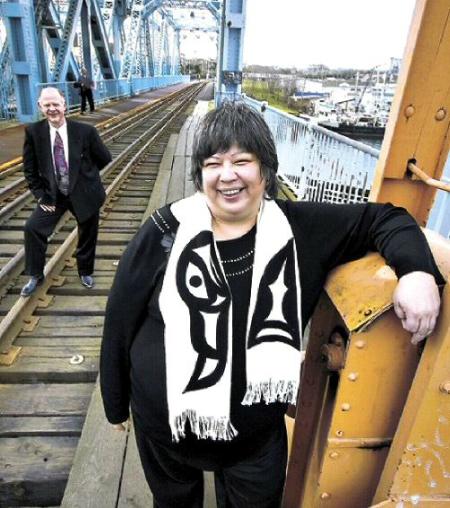
28 February 2006
E&N Line Donated to Islanders

Judith Sayers, chief of the Hupacasath First Nation in Port
Alberni, and Lake Cowichan Mayor Jack Peake, co-chairs of the Island Corridor Foundation, proudly
stand near the southern terminus of the Island's rail line after a historic agreement was reached with the CPR
Monday that transferred the corridor's title to the foundation.
|
Vancouver Island - The Age of Rail is being preserved on Vancouver Island with a donation
valued at $236 million, say a group of municipal politicians and First Nations leaders.
In what the non-profit Island Corridor Foundation is calling a historic agreement, the Canadian Pacific Railway has agreed
to hand over its Island rail assets to the foundation, a partnership of First Nations and local governments along the E&N line.
CPR is donating its portion of the 234-kilometre E&N, which averages 30 metres in width between Victoria and Courtenay,
to the foundation. That encompasses 651 hectares of land, six historic railway stations and a number of trestles. The company is also
supplying $2.3-million in "seed money" to help the foundation continue its work.
"Transfer of title has been completed, the Island corridor is now Island-owned and it's connecting communities,"
said a jubilant Judith Sayers, chief of the Alberni Valley's Hupacasath First Nation and co-chair of the foundation. Sayers
and her daughter, Alana, completed Monday's announcement of the deal at Capital Regional District headquarters with a traditional song
of thanks to the CPR's Dave Craig.
Not included in the deal is a section between Nanaimo and Parksville, which is owned by RailAmerica. The foundation is negotiating to
also take it over.
VIA Rail continues to operate a passenger service on the E&N line, but has tried to shut it down several times, saying it's not a
profitable venture.
Monday's deal will help preserve rail service on Vancouver Island and keep the E&N corridor available for such things as power
lines, pipelines and hiking trails, foundation officials said. The ownership change will also allow more flexibility to deal with local
concerns.
Priorities include:
- Signing a deal to continue passenger rail service;
- Upgrading the line;
- Developing other proposals for the corridor, including a commuter rail service in the south.
The first section of the E&N line, between Esquimalt and Nanaimo, was built between 1884 and 1886. CPR bought it in 1905, and
continued to operate on the Island until the late 1990s, when it decided that there wasn't enough business to continue. RailAmerica
later took over part of the line for a freight service.
"For our company, we had to look at it as "Did it make business sense to hold onto it any longer?" and it made more
sense to work with the Island Corridor Foundation to come up with a community-based solution," said CPR spokesman Ed
Greenberg.
He said CPR gets about one-sixth the value of the deal in a charitable tax credit, and that such deals are not uncommon
for the company.
"We just sold a spur line to the City of Richmond and we donated a railway station to the community of Nelson recently," said
Greenberg.
Also being discussed is the scope of rail service along the corridor and the establishment of a leasing arrangement with a company to
run the service, said Lake Cowichan Mayor Jack Peake, the foundation's co-chair. A viable commuter rail service is one
topic of discussion, he said.
He said the foundation wants to show what can be done with a grassroots rail service, and with the unique partnership that has been
created among the five regional governments and 13 First Nations within the corridor area.
"I think one of the things [where] Canada is still lagging behind the rest of the world is recognizing the value that the
railway corridors bring to this country that we live in," Peake said.
|